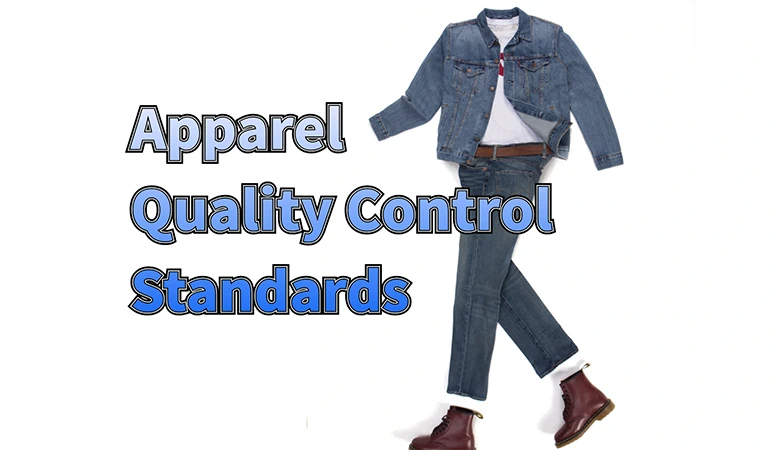
In the clothing industry, quality control is a crucial process that ensures that the final product meets specific standards in terms of fit, durability, safety, and aesthetics.
Quality control involves inspection, testing, and processes at various manufacturing stages, aiming to identify and rectify defects, spanning from raw materials to finished products. Through these processes, not only are products improved, but they are also ensured to comply with international regulations and customer expectations.
1. International quality standards for clothing
As clothing manufacturers expand globally, adhering to international quality standards becomes increasingly important.
Global compliance ensures that apparel products gain widespread acceptance in diverse markets and also guarantees that these products meet the necessary regulatory and safety requirements of various countries. For apparel manufacturers, compliance is crucial to avoid legal fines, product recalls, and damage to brand reputation.
In international trade, different countries and regions have varying requirements for the quality, safety, and environmental protection of imported goods. Clothing, as a necessity in daily life, has a direct impact on consumers' health and safety. Compliance with international quality standards has become a "passport" for clothing manufacturers to enter new markets. By ensuring that their products meet international standards, manufacturers can earn the trust of consumers and stand out in fierce market competition.
Among numerous international quality standards, ISO 9001 and ISO 14001 are undoubtedly the two most crucial ones.
ISO 9001 is an international quality management system standard that requires manufacturers to establish and implement a comprehensive quality management system to ensure that products consistently meet customer needs and expectations. The standard focuses on the final quality of the product and emphasizes the importance of process control and continuous improvement. By adhering to the ISO 9001 standard, clothing manufacturers can enhance production efficiency, reduce the rate of defective products, and thereby enhance market competitiveness.
ISO 14001 is an environmental management system standard that focuses on the environmental management performance of enterprises. In today's society, sustainable development has become a global consensus, and consumers' demand for environmentally friendly products is growing. Compliance with ISO 14001 standards means that clothing manufacturers pay attention to environmental protection during the production process and take effective measures to reduce pollution and waste. This not only helps enhance the brand image but also meets the needs of an increasing number of consumers who prioritize sustainable development.
2. Quality control of fabrics and materials
To ensure that clothing can withstand prolonged wearing and use, rigorous fabric testing and inspection procedures are particularly crucial.
Durability testing, as a crucial aspect of this process, aims to comprehensively evaluate the performance of fabrics under various usage conditions. This testing encompasses multiple aspects, with tensile strength testing being a primary consideration. This test evaluates the fabric's ability to withstand tension by simulating its behavior under tensile forces, ensuring that the fabric is not prone to tearing or deformation during normal use. Abrasion resistance testing is also an indispensable part. By simulating the wear of fabrics under repeated friction, this test assesses the durability of the fabric, ensuring that clothing maintains a good appearance and texture even after prolonged wear.
Pilling resistance testing is also an important component of fabric durability testing. Pilling is a common phenomenon that occurs to fabrics after prolonged use, affecting not only the aesthetics of clothing but also potentially reducing wearing comfort. Through pilling resistance testing, the performance of fabrics in this regard can be effectively evaluated, ensuring that clothing maintains a like-new appearance even after prolonged use.
In addition to durability testing, ensuring that the fabric composition meets the requirements is also crucial in fabric quality control. The correctness of fabric composition has a vital impact on the comfort, durability, and performance of clothing. During the production process of fabrics, strict verification of fabric composition is necessary.
Fiber content analysis is one of the important means to verify the composition of fabrics. Through scientific testing methods, the content of various fibers in the fabric can be accurately analyzed to ensure that the fabric composition is consistent with the product design requirements. Shrinkage testing is also an important step to ensure the integrity of the fabric. By simulating the washing and drying processes, the shrinkage of the fabric can be evaluated to ensure that the garment can maintain its appropriate size and shape after washing.
3. Dimensions and fit standards
In the clothing industry, accurate sizing is a crucial factor in ensuring that garments fit well and meet customers' expectations.
If there are deviations in size, it will not only lead to customers finding the clothing ill-fitting upon receipt, resulting in returns, but also trigger customer dissatisfaction, thereby causing irreparable damage to the brand's reputation. To effectively avoid such issues, the brand needs to establish and adhere to a standardized size chart, while continuously collecting consumer feedback to promptly identify and adjust any size deviations. This will help the brand maintain consistency in sizing and enhance customer trust in the brand.
Maintaining consistency in dimensions across different product lines is equally crucial.
Manufacturers can achieve this goal through various methods. Standardized pattern making is the foundation, ensuring comparability and consistency in dimensions across different styles and series of products through unified pattern making standards. The sample garment fitting process is indispensable. Inviting models or consumers of different body types and sizes to try on the clothes can intuitively identify size issues and make timely adjustments. Collecting feedback from consumers in different regions is also crucial. Consumers in different regions may have differences in body characteristics and size preferences. By analyzing this feedback, manufacturers can optimize the size settings specifically to meet the needs of customers in different regions.
To further ensure consistency across all sizes, the brand also needs to conduct regular fit audits.
During the process, professional fashion designers, pattern makers, and consumer representatives can be invited to participate in a detailed inspection and evaluation of clothing in different sizes. Comparative analysis can be conducted on the dimensions of various key parts such as shoulder width, sleeve length, waist circumference, and pants length to ensure that clothing in each size achieves the desired fit effect.
With the aid of advanced measurement tools, such as 3D body scanners and high-precision clothing measurement equipment, it is possible to obtain more precise clothing size data, providing strong technical support for size adjustment and quality control. In the fierce market competition, precise sizes and excellent fit have won the favor of consumers, establishing a good brand image.
4. Sewing and seam quality guidelines
In the garment manufacturing process, the quality of sewing and seams is directly related to the durability, comfort, and overall appearance of the clothing.
Sewing strength affects the durability of clothing and is directly related to its performance during wear. To ensure that the sewing strength meets standards, manufacturers must select the appropriate sewing type and thread density based on the type of fabric and the purpose of the clothing. For example, for heavy fabrics such as denim or canvas, stronger and thicker threads should be used for sewing to ensure that the seams can withstand greater tension and wear. For lightweight fabrics such as silk or cotton-linen blends, thinner threads should be selected to avoid making the seams bulky, which can affect the overall aesthetics and comfort of the clothing.
In addition to the standard setting of suture strength, manufacturers must also pay close attention to potential defects that may occur during the sewing process. Common sewing defects include skipped stitches, uneven stitching, or loose threads, all of which can seriously affect the integrity and durability of clothing. Skipped stitches can lead to holes in the seams, making the clothing prone to tearing; uneven stitching can result in an uneven appearance, affecting aesthetics; and loose threads can cause the stitches to fall off, quickly damaging the clothing during wear.
To avoid these sewing defects, manufacturers can take a series of measures. Introducing automated sewing quality inspection equipment is an effective option. These devices can quickly and accurately detect defects in the sewing process and make timely corrections, thereby greatly improving the sewing quality. Manual inspection is also an indispensable part. Experienced workers can identify defects that may be missed by automated equipment through visual inspection and hand feel, ensuring that every garment meets the highest sewing standards.
5. Color matching and dyeing standards
Ensuring color consistency across all production batches of clothing is a crucial aspect of maintaining brand image and enhancing product quality. Inconsistency in color can lead to mismatches between products, affecting consumers' purchasing experience, potentially damaging the brand's reputation, and reducing market competitiveness.
To ensure color consistency, manufacturers need to utilize professional color matching tools. These tools can accurately capture and identify colors, providing strong support for color control during the production process. Among them, the spectrophotometer, as a high-precision color measurement instrument, can accurately measure the color values of fabrics, helping manufacturers monitor and adjust colors in real-time during the production process, ensuring that the color of each batch of products remains consistent with the standard color.
In addition to the use of color matching tools, the best practice for fabric dyeing is also crucial to ensure vibrant and uniform colors. Manufacturers need to follow standardized dyeing processes and strictly control various parameters during the dyeing process, such as temperature, dye concentration, and water quality. Temperature control is crucial for dye penetration and fixation. Too high or too low a temperature can lead to uneven dyeing or color fading. Accurate adjustment of dye concentration is key to ensuring vibrant colors. Too high or too low a concentration can affect the final dyeing effect. The quality of water also directly affects the quality and stability of dyeing. Therefore, manufacturers need to choose high-quality water sources and carry out necessary treatment to ensure the smooth progress of the dyeing process.
Testing color fastness is also an indispensable part of the fabric dyeing process. Color fastness refers to the ability of a fabric to maintain its original color under conditions such as washing, friction, and exposure to light. Through professional color fastness testing, manufacturers can evaluate the color stability of the fabric during long-term use, ensuring that the color does not fade or discolor after washing or wearing, thus meeting consumers' demands for high-quality clothing.
6. Post-processing technology and quality assurance
In the garment manufacturing process, post-processing techniques can significantly enhance the performance and appeal of fabrics, while also adding unique charm and value to the final product.
There are various common post-treatment techniques, among which softening treatment, wrinkle resistance treatment, and shrink resistance treatment are particularly crucial.
Softening treatment is a post-treatment technique that enhances the softness and comfort of fabrics. Through specific chemical or mechanical methods, it can effectively improve the texture of the fabric, making it more skin-friendly and smooth.
Anti-wrinkle treatment was developed to address the issue of fabric wrinkling. Through special chemical treatments or heat setting techniques, it can effectively reduce wrinkles caused by wearing or washing, maintaining the flatness and aesthetics of clothing.
Anti-shrinking treatment is a post-treatment technology specifically designed for fabrics prone to shrinkage. Through pretreatment or special chemical treatment, the shrinkage rate of the fabric can be effectively controlled, ensuring that the garment maintains its original size and shape even after washing.
The successful application of post-processing technology does not solely depend on the selection and implementation of technology. In the post-processing stage, quality control is equally crucial. After garment production is completed, post-processing steps such as pressing, folding, and ironing play a decisive role in maintaining the final appearance of the garments. These steps require exquisite craftsmanship and skill, as well as strict quality control inspections to ensure that each garment reaches its optimal state.
During the quality control inspection in the post-processing stage, the workers conduct a comprehensive examination of the clothing to ensure that there are no defects before packaging. Whether it's wrinkles, poor shape, or any other issues, they need to be promptly identified and rectified. Only in this way can we ensure that the clothing ultimately presented to consumers is flawless and fully embodies the charm and value of the brand.
7. Packaging and labeling regulations
In the production chain of the garment industry, packaging and labeling are crucial for the appearance and transportation safety of products, and they also directly impact consumers' purchasing experience and brand reputation.
When it comes to the correct packaging method for clothing products, it is imperative to emphasize its importance in preserving the integrity of the garments. Well-designed packaging can effectively prevent clothing from being squeezed, rubbed, or contaminated during transportation and storage, thereby ensuring the perfect preservation of the garments' shape, avoiding wrinkles or maintaining their original cleanliness. Such packaging enhances the overall quality of the product and provides consumers with a more satisfactory unboxing experience. Packaging design must also strictly adhere to industry standards, including but not limited to dimensions, material selection, and label placement, to ensure product compliance and market competitiveness.
Let's delve into the guidelines for accurate and informative labels. As the "identity card" of clothing products, labels carry crucial information about the product, such as material composition, care instructions, country of origin, and size. The accuracy of this information is of utmost importance to consumers. On one hand, accurate labels ensure that the product complies with relevant laws and regulations, preventing legal disputes caused by incomplete or incorrect information. On the other hand, they help consumers gain a more comprehensive understanding of the product's characteristics and usage methods, enabling them to make more informed purchasing decisions.
Specifically, the material composition label enables consumers to understand the fabric composition of clothing, which is particularly important for consumers with allergies or those who pursue specific fabric textures. The care instructions label provides guidance on cleaning, ironing, and other maintenance aspects, helping to extend the lifespan of clothing. The country of origin label reflects the product's origin information, providing reference value for consumers who pursue the quality of the origin. The size label is a key basis for consumers to choose suitable clothing.
Therefore, when designing and producing labels, manufacturers must ensure the accuracy of all information and adhere to clear and readable format specifications, so that consumers can easily obtain the necessary information. At the same time, with consumers' increasing concern for environmental protection and sustainable development, labels can also include information about environmentally friendly materials, recyclability, or environmental protection measures during the production process, to meet consumers' green consumption demands.
8. Inspection and testing process
Through various types of inspections and crucial testing methods, manufacturers can effectively monitor every aspect of the production process, ensuring that the final product meets all quality standards and fulfills consumers' expectations and demands.
Let's discuss different types of inspections. Pre-production inspection is the starting point of the entire inspection process, ensuring that the materials and samples used fully meet the specification requirements. During this stage, the manufacturer conducts a detailed inspection of raw materials, including fabrics, accessories, and components, to ensure that their quality, performance, and appearance meet the design standards. At the same time, sample production is also an important part of pre-production inspection. By producing and inspecting samples, the manufacturer can identify potential design or process issues early on, laying a solid foundation for subsequent mass production.
In-process inspection is a crucial step in monitoring the production process. During the production process, various factors such as equipment malfunctions, operational errors, or fluctuations in raw materials can lead to product defects. Therefore, in-process inspection is particularly important. Through regular or irregular in-process inspections, manufacturers can promptly identify and correct problems in the production process, preventing defective products from entering the next process and ensuring the stability and controllability of the production process.
The final inspection is the concluding work of the entire inspection process, ensuring that the finished products meet all quality standards. During the final inspection stage, the manufacturer conducts a comprehensive inspection of the appearance, dimensions, sewing process, and accessory installation of the finished products, ensuring that each product meets the design requirements and customer expectations. Only products that pass the final inspection can be allowed to leave the factory for sale, thus safeguarding the rights and interests of consumers and the reputation of the brand.
In addition to various types of inspections, important testing methods are also crucial for ensuring the quality of clothing. Shrinkage testing is an important indicator for evaluating the dimensional stability of fabrics after washing. Through shrinkage testing, manufacturers can understand the shrinkage of fabrics during the washing process, adjust cutting sizes and sewing techniques, and ensure that the finished product maintains its appropriate size and shape during wear.
Tensile strength testing assesses the ability of fabrics or stitches to resist breaking when subjected to external forces. This testing is crucial for ensuring the durability of clothing during wear. Through tensile strength testing, manufacturers can understand the strength properties of fabrics or stitches, select suitable materials and processes, and enhance the durability and reliability of their products.
Color fastness testing assesses the ability of fabric colors to retain their original hue under conditions such as washing, friction, or exposure to light. Fabrics with poor color fastness may fade or discolor during wear or washing, significantly affecting the appearance and quality of clothing. Through color fastness testing, manufacturers can understand the color fastness performance of fabrics and take necessary measures to enhance it, ensuring that clothing maintains vibrant colors and a good appearance over long-term use.
9. Guidelines for Environment and Sustainable Development
For the garment industry, adhering to environmental standards and implementing sustainable manufacturing practices is not only a necessary choice in response to market demands, but also a significant measure to demonstrate corporate social responsibility and promote long-term development.
Meeting environmental standards is the first step for apparel companies to embark on a green transformation. International standards such as REACH (Registration, Evaluation, Authorization and Restriction of Chemicals) and OEKO-TEX (Certified Safe Textiles) play a crucial role. The REACH standard requires companies to register, evaluate, authorize, and restrict the use of chemicals in the production process, ensuring their safety and harmlessness to human health and the environment. The OEKO-TEX certification is a comprehensive verification of textile safety, covering the entire production process from raw materials to finished products, ensuring that products do not contain harmful substances and meet high standards for human health and environmental protection. Adhering to these environmental standards demonstrates a company's commitment to reducing environmental impact and promoting health and safety, and also earns the trust and favor of consumers.
In addition to meeting environmental standards, implementing sustainable manufacturing practices is also an indispensable part of apparel enterprises. Manufacturers can achieve this goal through various means. Reducing waste is one of the core principles of sustainable manufacturing. Enterprises can effectively reduce resource waste and maximize resource utilization by optimizing production processes, improving material utilization, and reducing waste production. Using renewable energy is another important sustainable practice. The utilization of renewable energy sources such as solar and wind energy can not only reduce dependence on traditional fossil fuels but also reduce carbon emissions during the production process, contributing to environmental protection. Purchasing environmentally friendly materials is also a key aspect of achieving sustainable manufacturing. Choosing fabrics, accessories, and components that meet environmental standards ensures that products have environmental attributes from the source, which is an effective way to meet consumers' environmental needs and enhance brand competitiveness.
Implementing sustainable manufacturing practices helps protect the environment and attracts an increasing number of environmentally conscious consumers. As consumers' awareness of environmental protection increases, they are more inclined to choose products that have environmental attributes and align with the concept of sustainable development. For apparel companies, implementing sustainable manufacturing practices is not only a responsibility and obligation, but also a market opportunity and development trend.
10. Worker Health and Safety Regulations
Ensuring safe working conditions in garment manufacturing is not only a clear requirement of laws and regulations, but also a manifestation of corporate social responsibility. Manufacturers must strictly comply with health and safety regulations and make every effort to protect workers from exposure to potential safety hazards of machinery or harmful chemicals.
To achieve this goal, manufacturers need to take a series of effective measures. Regular inspections and maintenance of production equipment are necessary to ensure that machinery is in good operating condition and potential safety hazards are promptly eliminated. Professional safety operation training should also be provided to workers to enhance their safety awareness and operational skills, preventing safety accidents caused by improper operation. For harmful chemical substances that may be used in the production process, manufacturers must strictly control their use and management to ensure that workers are not harmed by exposure to these substances.
Providing a safe working environment is not only a safeguard for employees' health but also a key to enhancing productivity. A safe and comfortable working environment allows employees to work with greater peace of mind, reducing downtime and losses caused by safety accidents, and improving production efficiency and product quality. A good working environment can also enhance employees' sense of belonging and loyalty, promoting the stable development of the enterprise.
In addition to ensuring safe working conditions, manufacturers must also comply with labor laws, regulating working hours, wages, and working conditions. This is a basic requirement for safeguarding workers' rights and maintaining the order of the labor market. Manufacturers should reasonably arrange workers' working hours, avoid excessive overtime and fatigue work, and ensure that workers have sufficient rest and entertainment time. They should also pay workers reasonable wages in accordance with laws and regulations to meet their basic living needs.
In addition, ethical standards are also important norms that manufacturers must adhere to. This includes ensuring fair treatment of workers and preventing any form of exploitation and discrimination. Manufacturers should respect the human dignity and labor value of workers, providing them with equal opportunities for career development and welfare benefits. Adhering to these ethical standards helps enhance the brand reputation of enterprises, and also strengthens consumer trust and support, laying a solid foundation for the long-term development of the enterprise.
END
The success of garment manufacturing relies on adhering to various quality control standards, ranging from fabric testing to worker safety regulations. By following these guidelines, manufacturers can ensure that their products meet customer expectations and regulatory requirements.
Adhering to these quality control standards assists manufacturers in reducing defects, enhancing product durability, elevating customer satisfaction, and establishing a robust brand reputation in the market. The success of apparel manufacturing stems from consistently delivering high-quality, regulatory-compliant products to consumers.


Smart Sourcing & Quality Assurance Content Team
Article by Smart Sourcing & Quality Assurance Content Team
The Smart Sourcing & Quality Assurance Content Team is dedicated to delivering high-quality, easy-to-understand information that empowers our audience to navigate the complexities of global sourcing and quality assurance. Our team of writers has extensive experience in creating content across various fields, including procurement, supply chain management, quality assurance, market trends, and industry best practices. We specialize in sectors such as apparel, textiles, and consumer goods, providing targeted insights to help businesses in these industries optimize their sourcing strategies, ensure product quality, and maintain a competitive edge in the market.
Grow your business with TradeAider Service
Click the button below to directly enter the TradeAider Service System. The simple steps from booking and payment to receiving reports are easy to operate.



